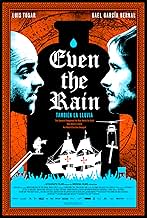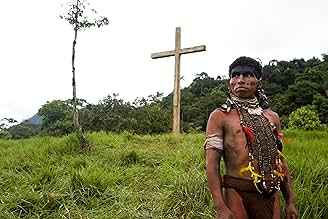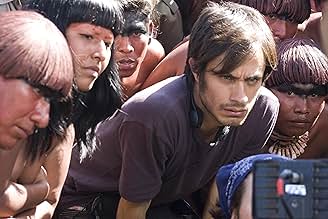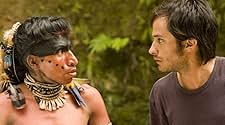IMDb RATING
7.4/10
15K
YOUR RATING
As a director and his crew shoot a controversial film about Christopher Columbus in Cochabamba, Bolivia, local people rise up against plans to privatize the water supply.As a director and his crew shoot a controversial film about Christopher Columbus in Cochabamba, Bolivia, local people rise up against plans to privatize the water supply.As a director and his crew shoot a controversial film about Christopher Columbus in Cochabamba, Bolivia, local people rise up against plans to privatize the water supply.
- Awards
- 22 wins & 17 nominations total
- Director
- Writer
- All cast & crew
- Production, box office & more at IMDbPro
Featured reviews
I first got wind of the political situation in Bolivia around the time of the 2003 protests, and then during the 2005 presidential election that brought coca farmer Evo Morales to power, making him the country's first indigenous president. Oliver Stone's documentary "South of the Border" partly told the story of the World Bank-inspired water privatization in Bolivia: the World Bank forced Bolivia's government to pass a law making it illegal for people to collect rain in buckets since it would have broken the monopoly on water ownership.
Icíar Bollaín's "También la lluvia" ("Even the Rain" in English) tells the story of the privatization, contrasting it with Christopher Columbus's genocide against the Indians. Filmmakers Sebastian (Gael García Bernal) and Costa (Luis Tosar) arrive in Cochabamba to make a movie about Columbus's arrival in the Americas, and the Taino Indians' subsequent rebellion against the occupation. But the events depicted in their movie begin to play out in real life: when the government sets out to privatize the water supply, the actor playing Taino leader Hatuey is one of the leaders of the protests.
The movie - which is dedicated to Howard Zinn - obviously has as its main purpose to show the parallels between indigenous resistance 500 years ago and today. But more than anything, it should offer incite into the roots of the wave of progressive leaders who rose to power in South America during the first decade of the 21st century. I definitely recommend it.
Icíar Bollaín's "También la lluvia" ("Even the Rain" in English) tells the story of the privatization, contrasting it with Christopher Columbus's genocide against the Indians. Filmmakers Sebastian (Gael García Bernal) and Costa (Luis Tosar) arrive in Cochabamba to make a movie about Columbus's arrival in the Americas, and the Taino Indians' subsequent rebellion against the occupation. But the events depicted in their movie begin to play out in real life: when the government sets out to privatize the water supply, the actor playing Taino leader Hatuey is one of the leaders of the protests.
The movie - which is dedicated to Howard Zinn - obviously has as its main purpose to show the parallels between indigenous resistance 500 years ago and today. But more than anything, it should offer incite into the roots of the wave of progressive leaders who rose to power in South America during the first decade of the 21st century. I definitely recommend it.
I found it very easy to identify with all of the main players thanks to some great performances from all involved and also a really nicely written script. It's really well shot with nice big, easily legible subtitles (more like this please foreign filmmakers!). It was interesting to see a film set in that region, we don't see very much from that part of the world. There are also some historical facts about the conquistadors that I wasn't aware of and so it even educated be a little! I love the way it slowly dawns on the crew that the mistakes made 500 years previously are still being made today! Over all, I found it well worth a look and it's one I would certainly look at again sometime.
SteelMonster's verdict: RECOMMENDED
My score: 8.3/10
You can find an expanded version of this review on my blog: Thoughts of a SteelMonster.
SteelMonster's verdict: RECOMMENDED
My score: 8.3/10
You can find an expanded version of this review on my blog: Thoughts of a SteelMonster.
I really enjoyed the film "Even in the Rain" because the movie had two stories going side by side. It was like a movie inside a movie, which was one thing that I really enjoyed about the movie. Overall the movie was very easy to understand. There might have been one scene that was not that clear to me but I got the general idea of it anyways so it was not really a big problem. If this was an American film the problem would have been solved in the movie, so it different from American films. To my understanding the problem was not resolved in this film. This film taught me how people in other parts of the world are living today and that people do not have the things that we take for granted all time. Also this film sort of taught us about the past which I taught was very interesting. It showed us how the British were treating the Natives. If was the director of this film I would have made it so at the end of the film everyone had water.
It would not be surprising if some day a film school professor chose 'También la lluvia' to illustrate a course about committed pictures, for this Spanish-Mexican co-production is indeed a model of its kind.
Intelligently written by Paul Laverty (Ken Loach's regular collaborator since 1996) and competently helmed by Icíar Bollaín (a Spanish actress turned director and, incidentally, Laverty's life companion), 'También la lluvia' examines a social and political event that took place in Bolivia in 2000, the Water War, when an American Water Company tried to privatize the drinking water service in the town of Corachamba, implying a tariff raise in an order from 40% to 300%.
To tell his story, the writer could have adopted the committed filmmaker's standard approach: «display of injustice/negative impact on the group concerned/reaction of the most militant/confrontation/resolution of the conflict». Instead, he imagined the coming of a film crew shooting a movie in the surroundings of Carachambo, getting involved gradually– and against their will - in the troubles affecting Corachamba. So do the viewers, who identify with them without having the feeling they are being manipulated by the authors.
Such a concept also gives 'También la lluvia' added value, making it function on several levels. It enables Laverty to: - inform his audiences about a little known historical event - unveil a hidden chapter of history (through the subject of the film shot within the film: the first opponents to the Conquistadores, Jesuits Bartolomé de las Casas and Antonio de Montesinos) - have the two stories echo each other and enrich each other - cast a spotlight on Bolivia, a neglected country, and on its Indian population - depict complex characters (the more idealistic ones shying away from direct action when confronted to danger while the more reactionary display unexpected bravery)
Helped by Iciar Bollain's sure-handed direction and by the excellence of the cast (Gabriel Garcia Bernal as Sébastián, the tormented director ; Luis Tosar as the cynical producer ; Karra Elejalde, impressive as the provocative star of the film in progress ; and - the revelation of the film, - the amazing Juan Carlos Aduviri, who inhabits his role as the Indian actor/activist Daniel), Paul Laverty manages to teach, move and entertain, while avoiding dogmatism, bias and over-simplification. Just what he is accused of by the flock of bleating French film critics.
Intelligently written by Paul Laverty (Ken Loach's regular collaborator since 1996) and competently helmed by Icíar Bollaín (a Spanish actress turned director and, incidentally, Laverty's life companion), 'También la lluvia' examines a social and political event that took place in Bolivia in 2000, the Water War, when an American Water Company tried to privatize the drinking water service in the town of Corachamba, implying a tariff raise in an order from 40% to 300%.
To tell his story, the writer could have adopted the committed filmmaker's standard approach: «display of injustice/negative impact on the group concerned/reaction of the most militant/confrontation/resolution of the conflict». Instead, he imagined the coming of a film crew shooting a movie in the surroundings of Carachambo, getting involved gradually– and against their will - in the troubles affecting Corachamba. So do the viewers, who identify with them without having the feeling they are being manipulated by the authors.
Such a concept also gives 'También la lluvia' added value, making it function on several levels. It enables Laverty to: - inform his audiences about a little known historical event - unveil a hidden chapter of history (through the subject of the film shot within the film: the first opponents to the Conquistadores, Jesuits Bartolomé de las Casas and Antonio de Montesinos) - have the two stories echo each other and enrich each other - cast a spotlight on Bolivia, a neglected country, and on its Indian population - depict complex characters (the more idealistic ones shying away from direct action when confronted to danger while the more reactionary display unexpected bravery)
Helped by Iciar Bollain's sure-handed direction and by the excellence of the cast (Gabriel Garcia Bernal as Sébastián, the tormented director ; Luis Tosar as the cynical producer ; Karra Elejalde, impressive as the provocative star of the film in progress ; and - the revelation of the film, - the amazing Juan Carlos Aduviri, who inhabits his role as the Indian actor/activist Daniel), Paul Laverty manages to teach, move and entertain, while avoiding dogmatism, bias and over-simplification. Just what he is accused of by the flock of bleating French film critics.
As a director named Sebastian (Gael Garcia Bernal)and his crew formed by his executive producer named Costa (Luis Tosar) and actors realize a controversial film about Christopher Columbus (Karra Elejalde) Bartolome De Las Casas (Raul Arevalo) , Montesinos (Carlos Santos) in Cochabamba , Bolivia, local people rise up against schemes to privatize the water supply . Spain Conquered the New World for Gold 500 Years Later, Water is Gold Not Much Else has Changed. Costa has chosen this place because the budget of the film is tight and extras are cheap , as he hires a rebel native (Iduviri) . The only thing that matters to him is his professional pride as a producer that the film is made on time and within budget.
This is an interesting and thought-provoking film dealing with actual and past deeds as the first explorations and the way the Spaniards treated the Indians at the time, the Cochabamba revolts , being well interwoven by screenwriter Paul Laverty and director . Top-notch main cast such as Gael Garcia Bernal as a good , idealist filmmaker and Luis Tosar as a selfish producer who wishes hire supernumeraries, local actors and extras on the cheap . Very good cinematography by Alex Catalan . Emotive and sensitive musical score by Alberto Iglesias .
The real events in which this brooding movie are based result to be the following : The Cochabamba protests of 2000, also known as the "Cochabamba Water Wars", were a series of protests that took place in Cochabamba, Bolivia's third largest city, between January 1999 and April 2000 in response to multinational participation in the infrastructure and management of the city's municipal water supply. Demonstrations erupted when Aguas del Tunari imposed a large rate increase, reportedly to finance a Dam project, a week after taking control of the Cochabamba water supply system. In a country where the minimum wage was less than US$70 per month, many dwellers were hit with monthly water bills of $20 or more. Starting in early January 2000 massive protests in Cochabamba began with Oscar Olivera among the most outspoken leaders against the rate hikes and subsequent water cut-offs. The demonstrators consisted of peasant Irrigators who entered the city either under village banners, or carrying the Wiphala; they were joined by retired . Young men began to try to take over the plaza and a barricade across incoming roadways was set up. Soon they were joined by pieceworkers, sweatshop employees, and street vendors . Anarchists from the middle-classes came from the University of Cochabamba to denounce the World Bank and International Monetary Fund and neoliberalism. The strongest supporters of the demonstration were drawn from the city's growing population of homeless street children .Protesters were able to halt Cochabamba's economy by holding a general strike that shut down the city for four straight days. A ministerial delegation went to Cochabamba and agreed to roll back the water rates; still the demonstration continued.On February 4, 2000, thousands marching in protest were met by troops and law enforcement . Almost 200 demonstrators were arrested; 70 protesters and 51 policemen were injured.Throughout March 2000 the Bolivian hierarchy of the Roman Catholic Church tried to mediate between the government and the demonstrators. In the meantime, the Coordinadora made their own referendum and declared that out of fifty thousand votes, 96% demanded the contract with Aguas del Tunari be cancelled. The government's reply under Hugo Banzer was that "There is nothing to negotiate.In April 2000, demonstrators again took over Cochabamba's central plaza. When the leaders of the Coordinadora went to a meeting with the governor at his office they were arrested. Though they were released the following day, some, fearing further government action, fled into hiding. More demonstration leaders were arrested, with some being transferred to a jungle prison in San Joaquin, a remote town in the Amazon rain forest on the border with Brazil. The demonstrations spread quickly to other areas including La Paz, Oruro, and Potosí as well as rural areas. The protesters also expanded their demands calling on the government to resolve unemployment and other economic problems.Soon demonstrators had most of the major highways in Bolivia barricaded. The protest even inspired officers in four La Paz police units to refuse to leave their barracks or obey superiors until a wage dispute was settled.
The motion picture is originally directed by Iciar Bollain . She has worked as a leading actress in selected films like The South (1983) by 'Victor Erice', Malaventura (1988) by 'Manuel Gutiérrez Aragon , Land and Freedom (1995) by Ken Loach, it became an acclaimed audience's and critics' choice ; Leo (2000) by 'Jose Luis Borau' that won the Best Actress nomination Goya Spanish Academy Awards and Nos Miran (2002) . She is a prestigious producer , writing and directing since then both documentaries and fiction films. In 1995, she wrote and directed her feature film debut, ¨Hola, ¿estás Sola?¨ (1995), awarded with Best New Director in Valladolid Festival and was nominated for Best Directorial Debut by the Spanish Film Academy. The film became one of Spain's 1996 box office hits. Flowers from another world(1999), was her second feature film and was awarded at Cannes Film Festival 1999, Best Film in the International Critics' Week ; ¨Take my eyes, 2003¨, was her following film as writer and director, winner of 7 Goyas Spanish Academy Awards, including Best Film, among many other international awards. Her next feature film is ¨Mataharis (2007)¨ and is filming ¨Katmandu¨.
This is an interesting and thought-provoking film dealing with actual and past deeds as the first explorations and the way the Spaniards treated the Indians at the time, the Cochabamba revolts , being well interwoven by screenwriter Paul Laverty and director . Top-notch main cast such as Gael Garcia Bernal as a good , idealist filmmaker and Luis Tosar as a selfish producer who wishes hire supernumeraries, local actors and extras on the cheap . Very good cinematography by Alex Catalan . Emotive and sensitive musical score by Alberto Iglesias .
The real events in which this brooding movie are based result to be the following : The Cochabamba protests of 2000, also known as the "Cochabamba Water Wars", were a series of protests that took place in Cochabamba, Bolivia's third largest city, between January 1999 and April 2000 in response to multinational participation in the infrastructure and management of the city's municipal water supply. Demonstrations erupted when Aguas del Tunari imposed a large rate increase, reportedly to finance a Dam project, a week after taking control of the Cochabamba water supply system. In a country where the minimum wage was less than US$70 per month, many dwellers were hit with monthly water bills of $20 or more. Starting in early January 2000 massive protests in Cochabamba began with Oscar Olivera among the most outspoken leaders against the rate hikes and subsequent water cut-offs. The demonstrators consisted of peasant Irrigators who entered the city either under village banners, or carrying the Wiphala; they were joined by retired . Young men began to try to take over the plaza and a barricade across incoming roadways was set up. Soon they were joined by pieceworkers, sweatshop employees, and street vendors . Anarchists from the middle-classes came from the University of Cochabamba to denounce the World Bank and International Monetary Fund and neoliberalism. The strongest supporters of the demonstration were drawn from the city's growing population of homeless street children .Protesters were able to halt Cochabamba's economy by holding a general strike that shut down the city for four straight days. A ministerial delegation went to Cochabamba and agreed to roll back the water rates; still the demonstration continued.On February 4, 2000, thousands marching in protest were met by troops and law enforcement . Almost 200 demonstrators were arrested; 70 protesters and 51 policemen were injured.Throughout March 2000 the Bolivian hierarchy of the Roman Catholic Church tried to mediate between the government and the demonstrators. In the meantime, the Coordinadora made their own referendum and declared that out of fifty thousand votes, 96% demanded the contract with Aguas del Tunari be cancelled. The government's reply under Hugo Banzer was that "There is nothing to negotiate.In April 2000, demonstrators again took over Cochabamba's central plaza. When the leaders of the Coordinadora went to a meeting with the governor at his office they were arrested. Though they were released the following day, some, fearing further government action, fled into hiding. More demonstration leaders were arrested, with some being transferred to a jungle prison in San Joaquin, a remote town in the Amazon rain forest on the border with Brazil. The demonstrations spread quickly to other areas including La Paz, Oruro, and Potosí as well as rural areas. The protesters also expanded their demands calling on the government to resolve unemployment and other economic problems.Soon demonstrators had most of the major highways in Bolivia barricaded. The protest even inspired officers in four La Paz police units to refuse to leave their barracks or obey superiors until a wage dispute was settled.
The motion picture is originally directed by Iciar Bollain . She has worked as a leading actress in selected films like The South (1983) by 'Victor Erice', Malaventura (1988) by 'Manuel Gutiérrez Aragon , Land and Freedom (1995) by Ken Loach, it became an acclaimed audience's and critics' choice ; Leo (2000) by 'Jose Luis Borau' that won the Best Actress nomination Goya Spanish Academy Awards and Nos Miran (2002) . She is a prestigious producer , writing and directing since then both documentaries and fiction films. In 1995, she wrote and directed her feature film debut, ¨Hola, ¿estás Sola?¨ (1995), awarded with Best New Director in Valladolid Festival and was nominated for Best Directorial Debut by the Spanish Film Academy. The film became one of Spain's 1996 box office hits. Flowers from another world(1999), was her second feature film and was awarded at Cannes Film Festival 1999, Best Film in the International Critics' Week ; ¨Take my eyes, 2003¨, was her following film as writer and director, winner of 7 Goyas Spanish Academy Awards, including Best Film, among many other international awards. Her next feature film is ¨Mataharis (2007)¨ and is filming ¨Katmandu¨.
Did you know
- TriviaThe scene where the little girl sees herself on screen was kind of a self homage by director/actress Icíar Bollaín. She wanted to transmit her first impression when she saw herself on screen being a teenager.
- ConnectionsFeatured in Ebert Presents: At the Movies: Episode #1.6 (2011)
- How long is Even the Rain?Powered by Alexa
Details
Box office
- Gross US & Canada
- $518,017
- Opening weekend US & Canada
- $53,730
- Feb 20, 2011
- Gross worldwide
- $7,313,485
- Runtime1 hour 43 minutes
- Color
- Sound mix
- Aspect ratio
- 2.35 : 1
Contribute to this page
Suggest an edit or add missing content


















